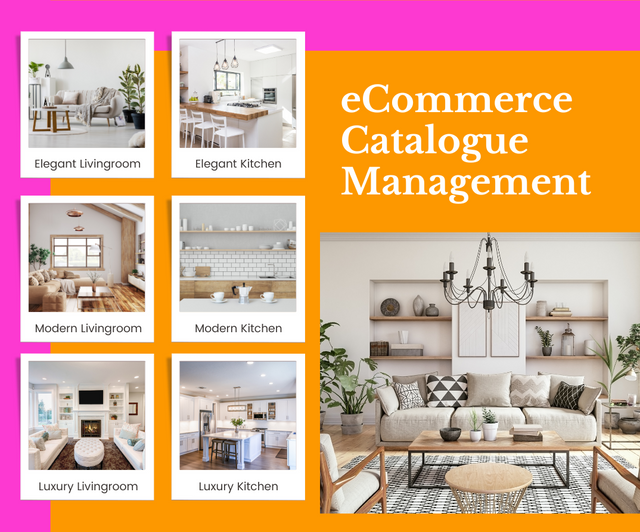How to Create an Irresistible eCommerce Catalogue Experience
An eCommerce catalogue is more than just a collection of products, it’s a gateway to customer engagement and conversion. In this article, we look into the art and science of curating an irresistible eCommerce catalogue experience. From strategic design elements and intuitive navigation to persuasive product presentation, we delve into the crucial components that elevate a simple catalogue into an immersive journey.
Let’s start with the basics… What is product catalogue management?
Product catalogue management involves overseeing the data and information of your product catalogue, ensuring its accuracy and organisation behind the scenes, while also shaping how it’s displayed on the front end of your eCommerce store. It’s the careful choreography of product details, categories and images to create a user-friendly shopping experience that entices customers and makes it easy for them to find and purchase what they’re looking for.
Why is effective product catalogue management important?
When a customer lands on your online store, you’re not just showing them products, you’re showcasing solutions to their needs and desires.
Effective eCommerce product catalogue management not only leads to an improved customer experience, but also unlocks a host of benefits that drive traffic, engagement and conversions for your eCommerce business.
In order to create those irresistible purchasing experiences you have to master your product catalogue management. Here are some key things to start with:
Enhanced Product Selection: offer a wide array of products and categories – variety drives 88% of shoppers to make purchases.¹
Reduced Friction: streamline the customer journey by presenting products and information clearly, reducing confusion and making navigation seamless.
Customer Queries: address customer enquiries proactively, fostering trust and minimising hesitation in the buying process.
Targeted Ads: categorise products effectively to enable precise ad targeting, resulting in more resonant and impactful marketing campaigns.
SEO Boost: optimise your catalogue with organised content and strategic keywords, elevating your website’s search engine rankings and visibility.
Actionable Insights: effortlessly track performance metrics, enabling data-driven decision-making and allowing you to focus on high-performing categories and products.
Consequences of poor product catalogue management
Poor product catalogue management can consist of inaccurate product information, inconsistent data and inefficient inventory management. This leads to cart abandonment, a high rate of returns.
Here are a few ways that your business can be impacted by poorly curated product catalogues:
Customer Indecisiveness: a cluttered and disorganised catalogue can overwhelm and confuse customers, making it challenging for them to make purchase decisions and resulting in higher support enquiries.
Low Product Visibility: difficulty in finding products directly impacts sales, rendering marketing efforts less effective when promoted items are buried deep within the catalogue.
Lack of Control Over Customer Navigation: failing to guide customers through the catalogue can cause them to miss out on promotional offers, new products and complementary products, which could have boosted the average order value.
No Scalability: adding new products manually can be a time-consuming process, leading to increased operational costs and a lack of agility in responding to trends. As the product management system grows, businesses could face performance issues such as slow data load time.
Bad Conversion Rates: cumulatively, these issues contribute to poor conversion rates and loss of revenue, highlighting the pivotal role of efficient product catalogue management in driving business success.
Best Practices For Effective Product Catalogue Design and Management
The key to product catalogue management is maintaining a centralised, clean and accurate product database – one database with all product features to keep your catalogue consistent and error free. Here are some best practices to design and manage your eCommerce catalogue effectively.
Implement a product taxonomy
Product taxonomy is a structured system for categorising and organising products in a hierarchical manner. It involves classifying products based on specific attributes, features and characteristics. The goal of product taxonomy is to create a clear and intuitive navigation framework for customers, making it easier for them to find products within an online store.
In essence, product taxonomy is like creating a well-organised library, where books are grouped into categories and subcategories based on their content. Similarly, in eCommerce, products are organised into meaningful categories that align with customer preferences and needs. This hierarchical arrangement enhances the user experience, allowing customers to locate products that match their interests in as few clicks as possible, resulting in improved navigation and overall satisfaction.
Defining product features and structure
When developing a product taxonomy, it’s important to define the attributes that matter most to your customers. This involves using data to gain a deep understanding of your target audience and the characteristics they prioritise when searching for products. Whether it’s size, colour, material, or technical specifications, these elements become the building blocks of your taxonomy.
Once you’ve identified these attributes, the next step is to create categories based on the customer’s perspective. Imagine walking into a physical store – the arrangement of products is often intuitive, allowing you to find what you need without much effort. Similarly, your online store’s categories should mirror how customers think about and explore products.
When it comes to the design and content of your product catalogue, consider the following important elements.
Takeaway: Maintaining a centralised, consistent and accurate product database is crucial for effective product catalogue management. Implementing a product taxonomy that aligns with customer preferences and needs can enhance the user experience, making it easier for customers to find and purchase products.
Clear and Consistent Product Imagery and Videos
85% of shoppers surveyed by Google say product information and pictures are important to them when deciding which brand or retailer to buy from.²
- Use high-quality images that showcase your products from multiple angles.
- Crop images to highlight key product features.
- Use lifestyle videos and images to illustrate how products can be used.
- Maintain consistent backgrounds, lighting and image sizes for a cohesive look.
- Incorporate zoom and 360-degree view features for a closer look at products.
Detailed Product Descriptions
- Provide accurate and comprehensive product information that includes features, specifications, dimensions, materials and benefits.
- Key information could be displayed in an engaging infographic style.
- Ensure that measurements are consistent across all products.
- Use bullet points, headers and subheadings to make information easily scannable.
- Incorporate relevant keywords for better SEO.
Consistent Branding
- Maintain consistent branding elements such as logos, colour schemes and typography across the catalogue.
- Ensure that the overall design reflects your brand’s identity and values.
User-Friendly Navigation
- Utilise clear menus, breadcrumbs and navigation paths to guide users through the catalogue.
- Include a “Home” button to allow users to quickly return to the main page.
Search and Filter Functionality
- Implement a robust search bar that provides relevant results even with typos or synonyms.
- Ensure that product tags are consistent across the catalogue.
- Include advanced filters and facets to help customers refine their search.
SEO Optimisation
- Optimise product titles, descriptions and metadata for search engines to improve visibility in search results.
- Use relevant keywords that customers are likely to use when searching for products.
Mobile-Friendly Design
- Design your catalogue with a responsive layout that adapts seamlessly to various screen sizes, especially mobile devices.
The product page details that hold significant influence for smartphone users, as outlined by Insider Intelligence, include product images/photos at 83%, product description/specs at 82%, and product reviews at 75%.³
Accessibility Considerations
- Design with accessibility in mind, ensuring your catalogue is usable by anyone at any time.
- Provide alt text for images and ensure a logical reading order for screen readers.
Regular Content Updates
- Keep product information accurate and up to date, including prices, availability and descriptions.
- Ensure that all this information can be easily updated in bulk to save time and reduce errors.
- Remove or mark products as “out of stock” to avoid disappointing customers.
Analytics and Testing
- Monitor user behaviour using analytics tools to understand how customers interact with your catalogue.
- Conduct A/B testing to optimise design elements, CTAs and overall user experience.
By following these best practices and adapting your approach based on customer feedback and industry trends, you can create a positive shopping experience for your customers.
Create an engaging interactive digital catalogue
By enabling active engagement, interactive digital catalogues offer a more immersive exploration of products, with features like 360-degree views, virtual experiences and interactive videos. This heightened engagement not only keeps customers on your site longer, but also fosters a deeper connection with your products.
Interactive eCommerce catalogues empower informed decision-making. Customers can delve into detailed descriptions, zoomable or animated images and clickable hotspots that highlight product features. This level of engagement ensures customers fully understand what they’re purchasing, reducing the likelihood of post-purchase disappointments, poor feedback and return of items.
By implementing an interactive catalogue on your eCommerce site, you can create a fun and memorable shopping experience for your customers that they will be keen to return to and recommend to others.
Takeaway: Incorporating clear and consistent product imagery, detailed descriptions and user-friendly navigation can improve the overall satisfaction of customers and increase conversions. Creating an engaging interactive digital catalogue can further enhance customer engagement and foster a deeper connection with products and your brand.
Examples of Great Product Catalogues
Ikea
Whether you’re browsing by individual products or exploring room by room, IKEA’s catalogue delivers an exceptionally immersive shopping experience. Each product image radiates life and warmth, so skillfully composed that you might believe you’re peering into an actual living room or kitchen. This starkly contrasts with the typical, uninspiring product shots set against lifeless backgrounds that you often encounter elsewhere.

Image source: www.ikea.com
Sephora
Sephora’s catalogue offers a pristine and meticulously organised aesthetic. Generous breathing space between each showcased product lends an air of luxury, while uniform detail levels, consistent photo sizes, and harmonious product positioning contribute to a seamless and coherent browsing experience.

Image source: www.sephora.co.uk
John Lewis
John Lewis features a mega-menu and an extensive range of products, spanning from furniture and electronics to apparel, cosmetics, toys, and more. Achieving seamless navigation across such a diverse product line is not easy, yet they manage it spectacularly.
The secret lies in their adaptive catalogue design, tailored to suit the specific needs of each product category. For instance, when you’re browsing through shoes, the catalogue presents a pleasing array of options that you can easily compare against each other. On the other hand, products like TVs are featured with larger images and are showcased in realistic settings. This tailored approach enables them to identify the optimal display strategy for each product type, resulting in a cohesive catalogue.

Image source: www.johnlewis.com
Lululemon
The Lululemon catalogue is remarkably responsive and flexible. As you select different colours for a product, the accompanying image dynamically updates in real-time, offering a preview of your chosen colour right within the catalogue view, before you even navigate to the individual product page. Hovering over an image reveals the product in an alternative setting, enriching the browsing experience and providing additional context without requiring a visit to the product’s dedicated page.

Image source: www.lululemon.co.uk
Product Management Tools – PIM and DAM: A Must Have
PIM (Product Information Management) and DAM (Digital Asset Management) systems are essential tools for efficient eCommerce catalogue management. A PIM system acts as a centralised hub for storing product information, including SKU details, descriptions, attributes and prices. In parallel, a DAM system handles related assets such as images and videos. Together, they create and maintain a comprehensive master catalogue, enriched with both detailed product data and visually engaging assets.
What are the benefits of using both PIM and DAM tools within OMS?
Integrating both PIM and DAM modules within OMS for eCommerce product management offers a comprehensive solution with a wide range of benefits.
Efficient Data and Asset Management: businesses can manage both product information and digital assets from a single interface.
Time and Cost Savings: provides the ability to automate various tasks such as data entry, asset transformation and content distribution. This reduces manual effort, accelerates workflows and leads to time and cost savings.
Unified Workflow: creates a cohesive workflow for teams, enabling seamless collaboration between departments involved in product data, asset creation, order processing and customer service.
Enhanced Marketing and Sales: marketing and sales teams are provided with immediate access to accurate product data and compelling visual assets. This speeds up campaign creation and ensures consistent brand messaging.
Optimised Listings: automated creation and updating of product listings across different platforms, ensuring consistency and reducing the risk of errors in product data and visuals.
Adaptation to Market Changes: enables businesses to quickly adapt to changing market trends and demands. New products can be launched faster, and adjustments can be made seamlessly.
Real-time Updates: changes made within the PIM and DAM tools are reflected in real time within the OMS. This ensures that all teams have access to the most current information and assets, reducing miscommunication and delays.
Data-Driven Insights: integrated systems provide valuable data insights about product performance, customer preferences and sales trends. This informs strategic decisions and enhances business growth.
Key features of effective product management platforms
Whichever product management system you choose to use, it should consist of these elements.
Auto-Resize Images: the ability to automatically resize images for different online marketplaces ensures consistent visual quality and optimises product display across platforms.
Templates: pre-designed templates for uploads simplify the process of adding new products, reducing manual effort and maintaining consistent formatting.
Reduced Go-to-Market Time: product management tools expedite the time it takes to launch new products, allowing businesses to respond quickly to market demands.
Seasonal Catalogue Management: tools that support managing seasonal products make it easier to update and maintain catalogues with changing product offerings.
Catalogue Filtering: the ability to filter and sort products based on different attributes or criteria enhances the ease of navigation and management.
One-Click Catalogue Cloning: this feature simplifies the creation of similar product listings, saving time and effort for products with similar attributes.
Inbuilt Quality Control: quality control checks within the tool help identify and rectify errors before product data is published.
Bulk Actions: the ability to perform actions like updates or deletions on multiple products simultaneously streamlines management tasks.
Dynamic Price Changes: tools that support dynamic price changes allow quick adjustments to pricing based on market trends or strategies.
Auto Category Mapping: automatic category mapping simplifies the process of assigning products to relevant categories on different platforms.
Scalability: as product portfolios grow, the scalability of the system is crucial to handle increasing volumes efficiently.
Takeaway: when used in tandem, PIM and DAM systems produce a comprehensive master catalogue, enriched with detailed, accurate product data and visually engaging assets. Benefits include efficient data and asset management, optimised listings, improved customer experience, and unified workflow.
Ready to take your eCommerce catalogue game to the next level? Get in touch and we can help your brand to produce a visually engaging and informative product catalogue that converts and drives business success.


